Difference between revisions of "PCh9 Lec 5"
Jump to navigation
Jump to search
| Line 16: | Line 16: | ||
:# As you can see in the Hydrogen Atom Schrodinger Equation on the bottom-left, the typical eq has the mass of the electron (''m<sub>e</sub>'') as opposed to the reduced mass (''μ''). Technically this is not incorrect, if the reduced mass is for the mass of the nucleus and the electron...the reduced mass of nuc/e- = nuc...so this term would then be considering the kinetic energy of the moving proton...but this is a different problem. If this is the H-atom Sch eq. it needs to be ''m<sub>e</sub>'' not ''μ''. Please remember that we are working under the [https://en.wikipedia.org/wiki/Born%E2%80%93Oppenheimer_approximation Born-Oppenheimer_approximation]. | :# As you can see in the Hydrogen Atom Schrodinger Equation on the bottom-left, the typical eq has the mass of the electron (''m<sub>e</sub>'') as opposed to the reduced mass (''μ''). Technically this is not incorrect, if the reduced mass is for the mass of the nucleus and the electron...the reduced mass of nuc/e- = nuc...so this term would then be considering the kinetic energy of the moving proton...but this is a different problem. If this is the H-atom Sch eq. it needs to be ''m<sub>e</sub>'' not ''μ''. Please remember that we are working under the [https://en.wikipedia.org/wiki/Born%E2%80%93Oppenheimer_approximation Born-Oppenheimer_approximation]. | ||
| − | :# It was a smart to use the [https://en.wikipedia.org/wiki/Del "del"] symbol (i cannot find this character- upside down Δ) to represent the 3D coordinates. As you can see in the middle, the ''del'' is shown in cartesian coordinates, but more useful form in QM for atoms are the spherical polar coordinates. | + | :# It was a smart to use the [https://en.wikipedia.org/wiki/Del "del"] symbol (i cannot find this character- upside down Δ) to represent the 3D coordinates. As you can see in the middle, the ''del'' is shown in cartesian coordinates, but more useful form in QM for atoms are the spherical polar coordinates (right). |
| − | :# | + | :# Now onto the potential energy term...they are missing the 4πε<sub>o</sub>. |
==Sec 9.5 Radial Probability Distribution Function== | ==Sec 9.5 Radial Probability Distribution Function== | ||
At this point you should be fully aware of the mathematical form of the hydrogen atom wavefunctions (see pages 170-171). It has taken us some time to develop these wavefunctions/eignefunction/orbitals. | At this point you should be fully aware of the mathematical form of the hydrogen atom wavefunctions (see pages 170-171). It has taken us some time to develop these wavefunctions/eignefunction/orbitals. | ||
Revision as of 13:37, 20 April 2020
(4/20/20, bes)
Greetings,
- I sent you all an email yesterday to hopefully help alleviate some stress associated with this new online format of teaching. Please read the mail and respond only if you choose to accept this option. It is my hope that all of you are not stressed, have good computing resources, have good internet, are following the posted notes (and are understanding these)...as well as well feed! Online pchem is certainly a challenge, but i feel we will all come out of this stronger!
Before we continue with the last lecture of the chapter, i wanted to discuss the White and Nerdy video shared in the last lecture...yes it is the hydrogen atom Schrodinger equation showing up in pop culture! First, Q: who is the person with Weird Al? ...A: it is click here...and if you wish to see him perform one of his Joseph and the Amazing Technicolor Dreamcoat tunes , click here.
Back to QM...Q: is this equation correct? A: no.
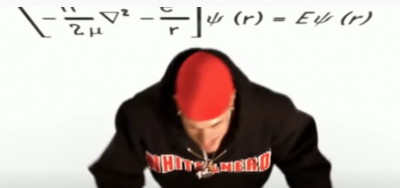 |
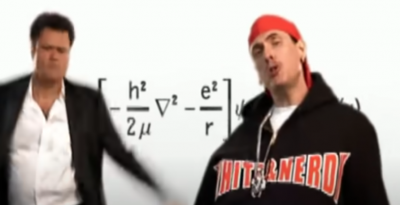
|
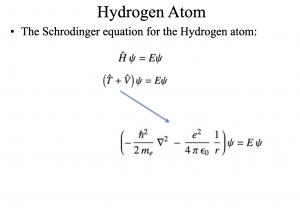 |
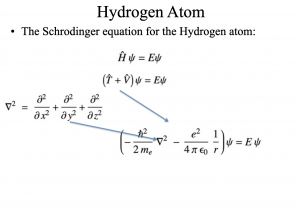 |
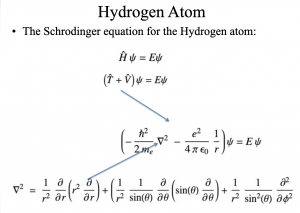
|
Comments/Corrections/Edits
- As you can see in the Hydrogen Atom Schrodinger Equation on the bottom-left, the typical eq has the mass of the electron (me) as opposed to the reduced mass (μ). Technically this is not incorrect, if the reduced mass is for the mass of the nucleus and the electron...the reduced mass of nuc/e- = nuc...so this term would then be considering the kinetic energy of the moving proton...but this is a different problem. If this is the H-atom Sch eq. it needs to be me not μ. Please remember that we are working under the Born-Oppenheimer_approximation.
- It was a smart to use the "del" symbol (i cannot find this character- upside down Δ) to represent the 3D coordinates. As you can see in the middle, the del is shown in cartesian coordinates, but more useful form in QM for atoms are the spherical polar coordinates (right).
- Now onto the potential energy term...they are missing the 4πεo.
Sec 9.5 Radial Probability Distribution Function
At this point you should be fully aware of the mathematical form of the hydrogen atom wavefunctions (see pages 170-171). It has taken us some time to develop these wavefunctions/eignefunction/orbitals.